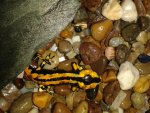Thank you for the advice, I will look into it soon as and see what a vet has to say.
Of course I read care sheets. The set up is larger, with at least one hide and paper towel over about a third. I have tried including moss and some soil/earth, they didn't seem to like it, selectively choosing the gravel. I will look at reducing the humidity if it is advised (it had been recently misted before this photo), to be honest I largely kept them in the way they had been before being passed onto me as they seemed to be doing fine.
They do all get fed regularly, but if you think this one looks thin I will offer food even more often.
Best,
James

